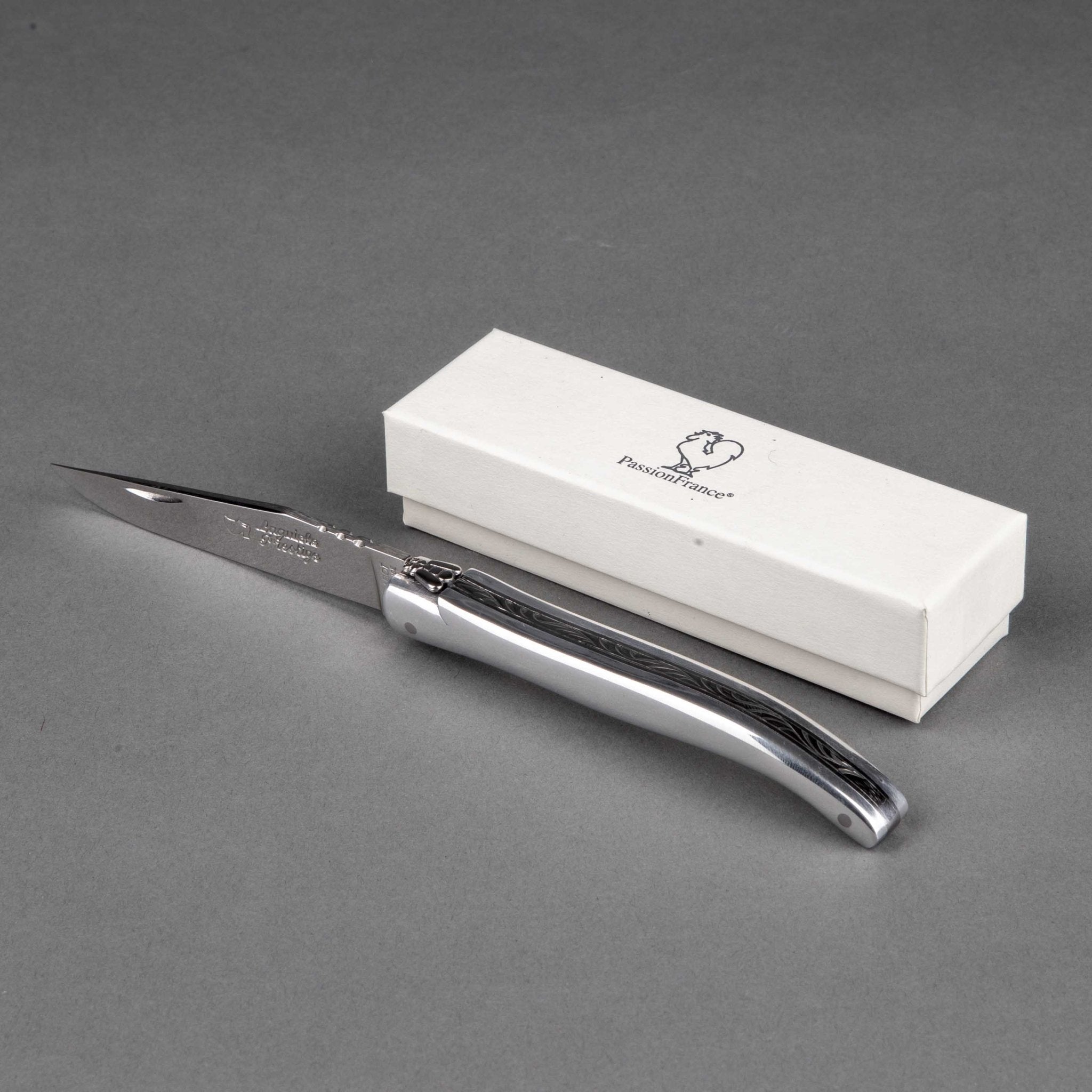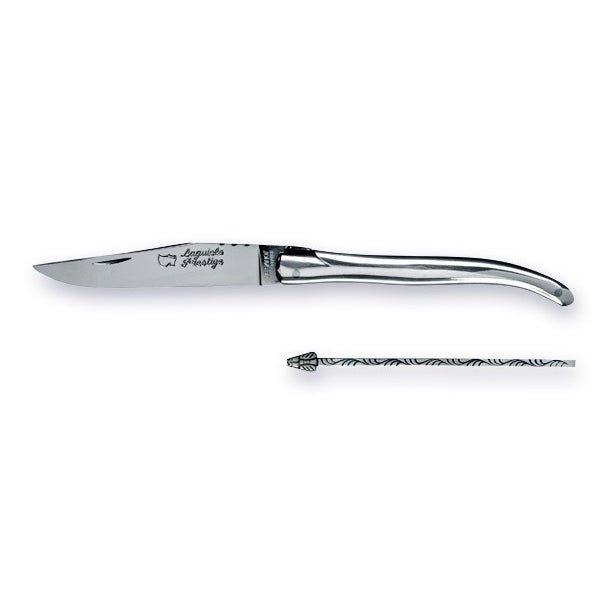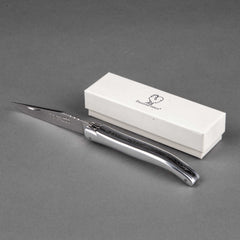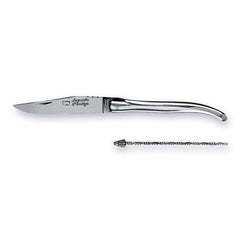Telefono: (+41) 41 530 00 31
Spedizione gratuita in CH/FL a partire da CHF 100
- La scelta di una selezione comporta l'aggiornamento dell'intera pagina.
Telefono: (+41) 41 530 00 31
Spedizione gratuita in CH/FL a partire da CHF 100




Compared to knives from other regions of France, the lines of a Laguioleare slim and elegant... unusually delicate for a knife that was at home in a farming environment, which consisted essentially of farmers and stockbreeders or routiers, who traveled through the country as traveling traders with their ox or donkey carts and traded in the products of their homeland.
One would think that knives for such a target group would not be as elegant as Laguioles are. But the surprising thing is that its slender handle fits so well in the hand and follows the lines of the hand so perfectly that it couldn't be stronger.
It is also undisputed that to date, none of France's numerous knives have provoked such a debate among architects, designers and creative people. A possible answer to this question probably lies in this special feature, its unusually elegant lines.
The story of the Laguioles has been told to us for years in the fairy tales and legends that circulate among the rural population of Aubrac and how they brought the blacksmiths into circulation. Once Upon a time …
- In 1828, a young blacksmith named Pierre-Jean Calmels created a knife that soon became the most popular knife in France because of its slender lines, elegance and balanced proportions.
- the Laguiole is a cross between the Capuchadou dagger common in Aubrac and a knife native to Spain called Navaja, which the traveling traders discovered and brought back with them on their travels.
- some say that real pocket knives that fold up, i.e. with a compartment in the back, did not exist until then. The invention of the modern pocket knife was an invention of the blacksmiths in Laguiole.
- the Croix Berger, the decoration called a shepherd's cross made of small metal pins on the handle, was once used by the shepherds for a quick prayer when they watched the dangerous nights with the animals in the pasture. It must consist precisely of 7 little nails, otherwise it is not real, because it symbolizes the days of the week.
- the fly on the resort is not a fly, but Napoléon's heraldic animal, a bee. The Emperor only granted the blacksmiths in Laguiole the right to depict his heraldic animal on their knives, because they had fought particularly bravely in his battles...
All of this flatters the narrator, is charming, but has nothing to do with the historical truth, as we know today.
Nevertheless, we should enjoy stories like the ones that embellish the world of Laguioles, because no other knife is told so frequently about them. And France has over sixty different traditional pocket knives! Some younger, but some much older than the Laguiole.
In addition to the legends, we can also get to know the historically correct story with the exact dates as it has recently become known:
- the first blacksmith shop founded in the village of Laguiole in 1828 was the Moulin blacksmith shop; The blacksmith Jean-Pierre Calmels, who is said to have invented the knife in 1828, only settled here a year later, in 1829, at the same time as the blacksmith Glaize. In the years that followed, other blacksmiths settled in Laguiole.
- for many it was never quite understandable that a very young blacksmith like Pierre-Jean Calmels (according to the story in 1828) at the age of only 16 should have "invented" a knife with such perfect lines. So not a seasoned blacksmith with craftsmanship experience or an experienced craftsman with design know-how? The knife is said to have been created immediately in its finished, final form, developed from a Navaja, which is structurally different, and a fixed dagger, the Capuchadou? Without intermediate steps in development? This leaves experienced designers and knife makers in doubt.
- Napoleon's bee in the department. Napoléon was deposed in 1815 and with his deposition and banishment all of his insignia had to be destroyed (see the rediscovery of the subject Napoléon), and it was forbidden under punishment to continue using his insignia, including his heraldic animal, the bee . Napoléon died in 1825. The first blacksmiths settled in Laguiole in 1828 and the first original Laguioles were created around 1850 as we know today...
Christian Lemasson is a historian and ethnographer. He lives in Aubrac near Laguiole and in Thiers. Coming from a family of Couteliers, he asked the same questions, spent 9 years researching the history and evolution of Laguiole knives and his forge, and published his research in 2010 in the book L'HISTOIRE DU COUTEAU DE LAGUIOLE. As part of his research, he was able to view more than just the documents in public archives. He was given access to private archives, including archives of some defunct blacksmiths in Laguiole and Thiers, whose families had kept the original documents. The results of his work allowed him to reconstruct the history of Laguiole on a secure scientific basis.
For anyone who would like to read the story in its entirety: we provided expert and advisory support for the German translation for Wieland-Verlag by Thomas Mößer.
This knife was manufactured by the Au Sabot company, with the wooden shoe as its trademark. Au Sabot looks back on 150 years of history, making it one of the oldest company histories in France. A few years ago the company was awarded the honorary title Patrimoine Vivant, living cultural asset.
A specialty of the company are the Laguioles à l'ancien, i.e. made in the old traditional way, which, like the Laguiole Art Déco, have been made for generations using the old tools and with the old attributes.
Since 1994, Au Sabot has been a member of the "Confrérie du Couté de Tié".
In 2008, the cutlery was honored with the Entreprise du Patrimoine Vivant award, which is given to manufacturers with special, traditional knowledge.
Folded length: 12cm, blade: 9.5cm, welded bee, aluminum handle
The knife is delivered in a black box with a cleaning cloth and a detailed description.
Spedizione prioritaria gratuita per ordini superiori a 100 SFr. Gli ordini vengono solitamente spediti lo stesso giorno lavorativo o quello successivo (se ordinati dopo le 15:00). Escluso il lunedì (nostro giorno di riposo).
Spediamo i pacchi all'estero con UPS. Il prezzo totale, comprensivo di spedizione, dogana e IVA, vi verrà mostrato nell'ultima fase del processo di checkout prima di completare l'acquisto. Tutti i costi sono già pagati qui nel negozio, nulla è dovuto al momento della ricezione (DDP - Delivered Duty Paid).
È possibile restituire la maggior parte degli articoli per un rimborso completo entro 14 giorni dalla consegna. Gli articoli devono essere restituiti in condizioni pari al nuovo (cioè non indossati, non lavati, con tutti i cartellini ecc.). Le spese di spedizione per la restituzione sono a nostro carico se la restituzione è dovuta a un errore da parte nostra (avete ricevuto un articolo non corretto o difettoso, ecc.).
Potete aspettarvi di ricevere il vostro rimborso entro una o due settimane dalla consegna del pacco all'ufficio postale/UPS, ma in molti casi sarà più veloce. Questo include il tempo necessario per ricevere il reso dal corriere (da 1 a 3 giorni lavorativi), il tempo necessario per elaborare il reso una volta ricevuto (1 giorno lavorativo) e il tempo necessario alla banca, alla società di carte di credito, a Postfinance, a Twint, ecc. per elaborare la richiesta di rimborso (immediatamente fino a 10 giorni lavorativi).Se si desidera restituire un articolo, indicare se si desidera un rimborso o un cambio.
Tutti gli articoli ordinabili sono solitamente disponibili e possono essere spediti immediatamente. In caso di errori, sarete informati immediatamente.
La maggior parte, ma non tutti, gli articoli esposti nel negozio web sono disponibili nei nostri negozi fisici. L'abbigliamento da moto può essere tenuto nel nostro magazzino fuori sede in inverno per motivi di spazio, così come la maglieria pesante, i cappotti o i cappelli autunno/inverno possono essere tenuti nel nostro magazzino fuori sede in estate.
Anche gli articoli singoli e gli articoli in vendita sono spesso conservati nel magazzino esterno.
Red Wing e altre calzature sono disponibili tutto l'anno.
È meglio informarsi su un articolo specifico prima di visitarlo.
Siete interessati a un articolo esaurito? Saremo lieti di informarvi se e quando sarà disponibile in magazzino.
Grazie per esserti iscritto!
Questa e-mail è stata registrata!
Il nostro obiettivo è quello di servirvi sempre con piena soddisfazione. Questo include anche i nostri termini e condizioni equi.
Inviando un ordine si accettano espressamente questi termini e condizioni.
Le consegne sono limitate agli indirizzi di consegna in Svizzera e nel Liechtenstein.
Forniamo solo prodotti nuovi di zecca e di qualità originale.
Condizioni di consegna:
Consegniamo il vostro ordine entro 2 giorni dal ricevimento dell'ordine o del pagamento tramite la Posta Svizzera. Gli ordini vengono solitamente inviati insieme in un unico pacco e non in spedizioni singole.
La maggior parte degli articoli è disponibile in magazzino e in pronta consegna. Per gli articoli non disponibili in magazzino, il tempo medio di consegna è di 4 settimane. Se un articolo non è disponibile a magazzino, sarete informati il giorno stesso o il giorno lavorativo successivo. Se gli articoli sono urgentemente necessari, chiedeteci informazioni sui livelli delle scorte.
Ordini e prezzi:
Tutti gli ordini sono vincolanti. In caso di ritardo nella consegna, sarete informati per e-mail o per telefono. Se la consegna non è ancora stata inviata, avete la possibilità di annullarla. Sono riservate le variazioni di prezzo e di gamma dei prodotti, nonché le modifiche tecniche. Tutte le offerte sono soggette a modifiche. Salvo errori e refusi.Pagamento
Nel webshop, gli ordini vengono elaborati in base a
- Carte di credito / Paypal
- Cartolina
- Twint
- Acquisto su conto con opzione di pagamento parziale (POWERPAY)
In qualità di fornitore esterno di servizi di pagamento, MF Group / POWERPAY offre il metodo di pagamento "acquisto su conto". Con la fattura individuale, potete pagare facilmente i vostri acquisti online tramite fattura. Se non pagate entro i termini stabiliti, riceverete una fattura mensile con un riepilogo degli ordini nel mese successivo.
Alla conclusione del contratto di acquisto, POWERPAY si fa carico della richiesta di fattura e gestisce i relativi termini di pagamento. Quando acquistate su conto, accettate i termini e le condizioni generali di POWERPAY oltre ai nostri (powerpay.ch/it/agb).
Consegne all'UE:
Le spese di spedizione con UPS, le spese di sdoganamento e l'IVA sono incluse nel prezzo totale (visibili nell'ultima fase del checkout). Non ci sono costi aggiuntivi al momento della ricezione (DDP - Delivered Duty Paid).
Spese di spedizione Svizzera / Principato del Liechtenstein:
Gli ordini con un valore d'acquisto pari o superiore a 100 franchi svizzeri saranno spediti gratuitamente.
Per gli ordini con un valore d'acquisto inferiore a 100 franchi svizzeri, addebitiamo 7 franchi svizzeri per la spedizione Economy e 9 franchi svizzeri per la spedizione Priority.
Rivenditori (B2B) su richiesta.
Politica di rimborso:
Se restituite la merce acquistata entro 14 giorni in perfette condizioni e nella confezione originale, vi rimborseremo l'intero prezzo di acquisto. Le spese di spedizione per la restituzione sono a vostro carico.
Protezione dei dati:
British Parts raccoglie dati e li utilizza per l'elaborazione degli ordini e per semplificare al massimo gli acquisti dei clienti abituali. I dati personali sono trattati con riservatezza e non vengono trasmessi a terzi per scopi pubblicitari.
Memorizziamo gli ordini aperti e quelli completati. Questi dati possono essere consultati in qualsiasi momento nell'area di login protetta da password.
In caso di domande sui nostri termini e condizioni contrattuali, vi preghiamo di contattarci via e-mail ( info@britishpartsluzern.ch ) o per telefono (041 530 00 31).
Le nostre attività commerciali si basano esclusivamente sul diritto svizzero. Il foro competente è Rothenburg.